Syncing from iManage Work using web extensions
From version 10.9.0 onwards, you can sync and open workspaces (or matters based on what is configured in your application), documents, emails, or folders from iManage Work using our web extensions in Microsoft Windows Explorer.
NOTE:
If you're already connected to iManage Work and can't view the Sync & Open in File Explorer option, sign off from iManage Work and sign in again.
Syncing a single workspace
Connect to iManage Work.
Select one of the following:
Recent Workspaces (alternatively Recent Matters) to sync your most recent workspaces.
My Workspaces (alternatively, My Matters) to sync your workspaces.
My Favorites to sync the workspaces you’ve saved as your favorites.
Select the workspace you want to sync and do one of the following:
On the iManage Work toolbar, select Sync & Open in File Explorer
 .
. Select the kebab menu
 next to the workspace and then select Sync & Open in File Explorer.
next to the workspace and then select Sync & Open in File Explorer.
The iManage Drive panel opens and prompts you to confirm the items that aren't synced. After confirming, the iManage Drive panel syncs the selected items. When the sync is completed, Windows Explorer opens with the synced items highlighted.
If the selected workspace is already synced to iManage Drive, you're taken directly to Windows Explorer where the item is highlighted.
Syncing multiple workspaces
You can sync multiple workspaces by doing the following:
Connect to iManage Work.
Select My Workspaces (alternatively, My Matters) and then select the workspaces you want to sync.
Select Sync & Open in File Explorer
 . The iManage Drive panel appears and the sync progress is displayed. After the sync is complete, Windows Explorer appears with the synced workspaces highlighted.
. The iManage Drive panel appears and the sync progress is displayed. After the sync is complete, Windows Explorer appears with the synced workspaces highlighted.
Syncing maximum number of workspaces
If your administrator has configured the maximum_matters_limit admin setting in the admin_setting.yaml file and if the number of workspaces you're syncing is more than the number specified in the maximum_matters_limit admin setting or a number more than the default value, the following message is displayed:

Select Manage synced Matters to continue syncing or Cancel to cancel the syncing. When you select Manage synced Matters, the following message is displayed.
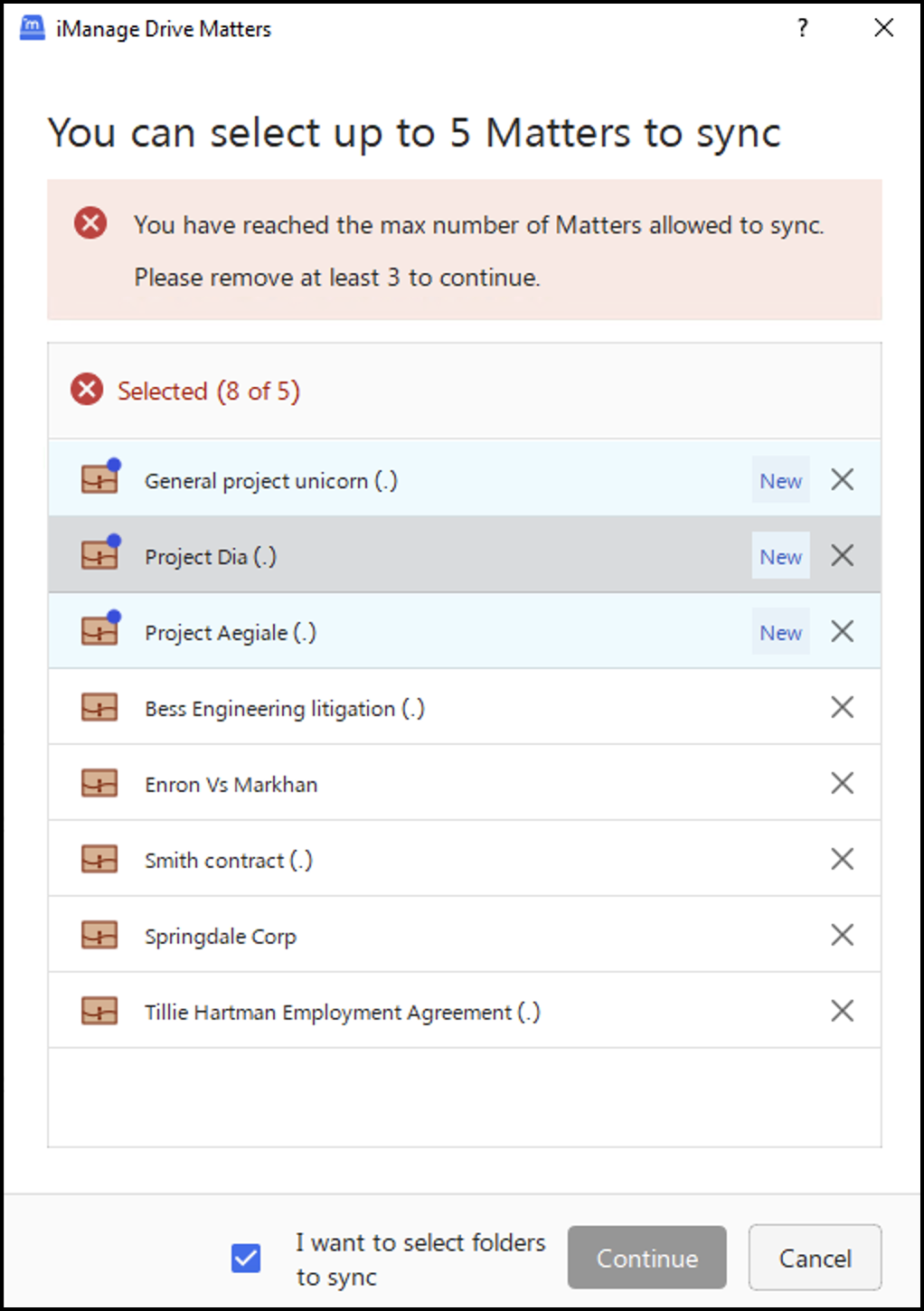
Select the workspaces that you no longer want to sync. If you already have workspaces that are synced, you have the option to select them as well. Selecting workspaces that are already synced unsyncs them from iManage Drive.
Selecting folders to be synced when syncing workspaces
When syncing workspaces, select the folders you want to sync by selecting the I want to select folders to sync check box as shown in the following figure. This option is selected by default.
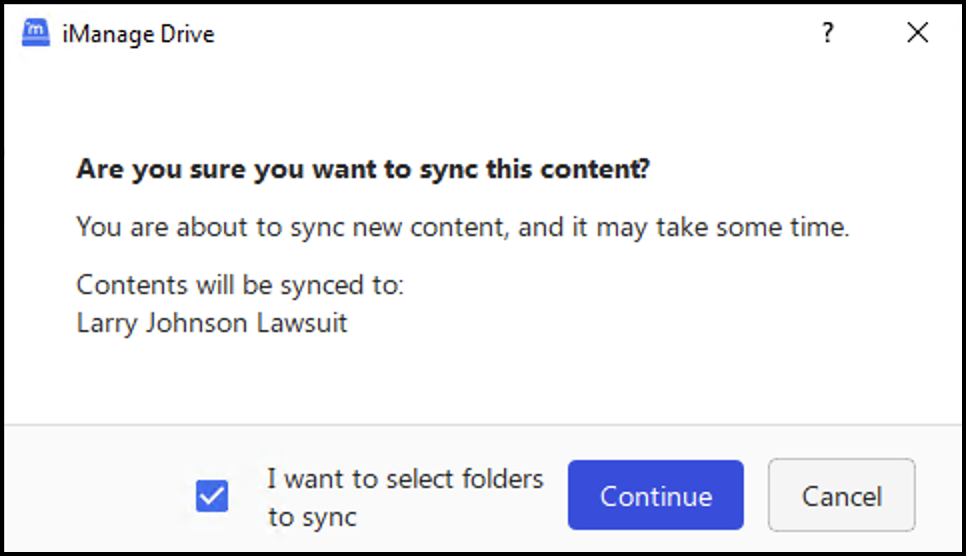
Select Continue to select the folders to be synced. The Select folders to sync window appears as shown in the following figure. Select the folders and then select Sync to sync the selected folders.
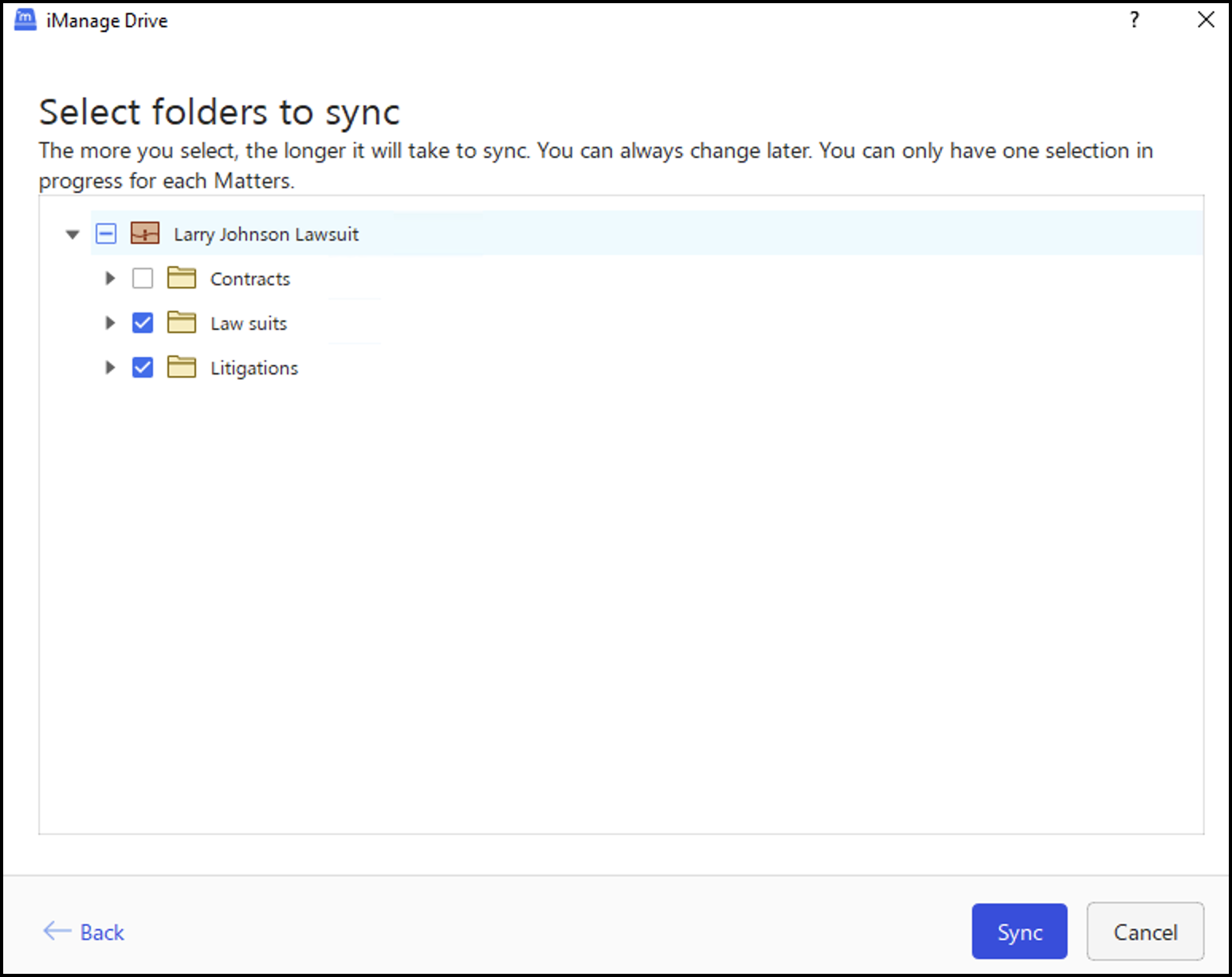
If you want to sync all the folders in the selected workspaces, deselect the I want to select folders to sync check box.
Syncing folders, emails, and documents
Method 1
Connect to iManage Work.
Select one of the following:
Documents to sync documents.
Emails to sync emails.
Folders to sync folders.
My Favorites to sync your documents, emails, or folders which you have saved as your favorites.
Select the document, email, or folder you want to sync and do one of the following:
On the iManage Work toolbar, select Sync & Open in File Explorer
 .
. Select the kebab menu
 next to the matter, document, email, or folder and then select Sync & Open in File Explorer.
next to the matter, document, email, or folder and then select Sync & Open in File Explorer.
The iManage Drive panel appears and prompts you to confirm the items that aren't synced. After confirming, the iManage Drive panel syncs the selected items. When the sync is completed, Windows Explorer opens with the synced items highlighted.
If the selected matter, folder, document, or email is already synced to iManage Drive, you're taken directly to Windows Explorer where the item is highlighted.
Method 2
From iManage Drive 10.11.0 onwards, we've enhanced the user experience when syncing folders and documents from iManage Work using our extensions. To use these enhancements, your administrator must set enable_folder_sync to true in the admin_settings.yaml file. Contact your administrator for more information.
After this admin setting is enabled,
Connect to iManage Work.
Select one of the following:
Documents to sync documents.
Emails to sync emails.
Folders to sync folders.
My Favorites to sync your documents, emails, or folders which you have saved as your favorites.
Select the document, email, or folder you want to sync and do one of the following:
On the iManage Work toolbar, select Sync & Open in File Explorer
 .
. Select the kebab menu
 next to the matter, document, email, or folder and then select Sync & Open in File Explorer.
next to the matter, document, email, or folder and then select Sync & Open in File Explorer.
Windows Explorer opens immediately while iManage Drive continues to sync the folder or the document in the background. Also, note that the prompt asking you to confirm the sync isn't displayed.
Additionally, when you select a folder for syncing, only the folder, the parent folder, and parent workspace are synced. Any subfolders within the synced folder and other folder in the parent folder and workspace are displayed as folder stubs. Similarly, when you select a file for syncing, the parent folder, and parent workspace are synced.
You can select the individual folder stubs and sync them using by doing either of the following:
Double-click the Double Click to sync content file that’s available in the folder stub.
Use the web extension to sync the folder stub.
Limitations
If a folder or folder stub has more than 9999 subfolders, you can't sync them using web extensions and the following error message is displayed
Figure: Error message when trying to sync more than 9999 subfolders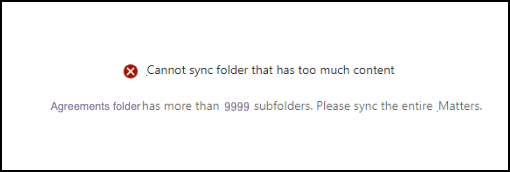
You can’t select folders for syncing using the Select Workspaces to Sync option available in iManage Drive panel. Users have to unsync the entire workspace to select folders using this option.
If administrators disable the enable_folder_sync admin setting after enabling it, iManage Drive restarts and unsyncs all the folders and files synced when the admin setting was enabled. Additionally, the Notifications tag in the iManage Drive panel displays the following notification:
“<folder name> was unsynced due to configuration change by your administrator.“
NOTES:
You can rename or move a folder stub. However, you can't delete the folder stub.
We don't recommend that users:
Rename the Double click to sync content file in a folder stub.
Add a file to a folder stub.
When users move a folder or file into a folder stub, they can no longer see the folder or file in iManage Drive.
Important points
Your administrator must enable the web extensions in iManage Control Center. For more information, contact your administrator or refer to the Enable web extension for iManage Drive section in iManage Drive Administrator Help.
If your administrator has set the
enable_folder_selection_syncadmin setting tofalsein the admin_settings.yaml file, when you sync documents, emails, or folder, the entire workspace is synced.Make sure that iManage Drive is running and you're connected to the same iManage Work account from which you want to sync the workspaces, documents, emails, or folders. If iManage Drive isn't running, the following error is displayed. The error displayed in the figure varies based on the browser you are using to access iManage Work.
Figure: Error displayed when iManage Drive isn't running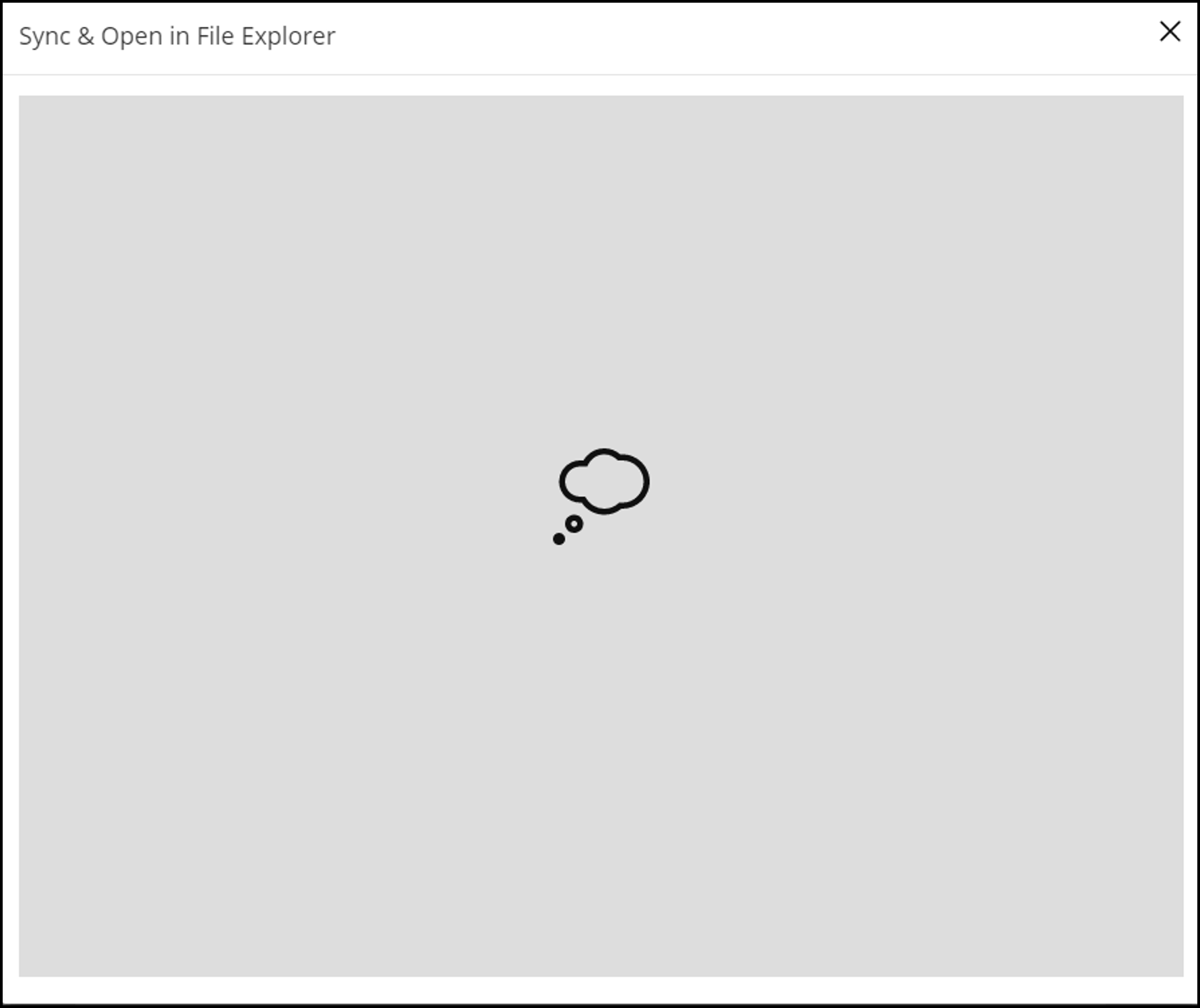
If iManage Drive is running but you're connected to a different account in iManage Drive and trying to sync from a different iManage Work account, the following error message is displayed:
Figure: Error when syncing from different iManage Work accounts
You can sync multiple workspaces from iManage Work. However, you can sync only a single document, folder, or email at a time.
You can't sync folder shortcuts, document shortcuts, or special folders such as Shared folders or search folders. The Sync & Open in File Explorer option isn't displayed.
When syncing a document, all the documents in the folder are automatically synced to your Windows Explorer.
After a sync, although Windows Explorer does open, it may remain minimized. If this occurs, you'll have to open Windows Explorer from the taskbar manually.
If you try to sync a matter or folder, or document, or email that's already synced to iManage Drive by selecting Sync & Open in File Explorer, it's automatically displayed in Windows Explorer.